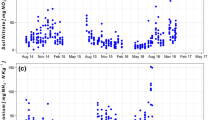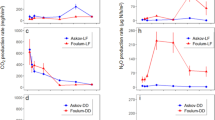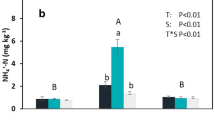Abstract
At cattle overwintering areas, inputs of nutrients in animal excrements create conditions favourable for intensive microbial activity in soil. During nitrogen transformations, significant amounts of N2O are released, which makes overwintering areas important sources of N2O emission. In previous studies, however, increasing intensity of long-term cattle impact did not always increase emissions of N2O from the soil: in some cases, N2O emissions from the soil were lower at the most impacted area than at the moderately impacted one. Thus, the relationships between the level of long-term animal impact and potential production of N2O from soil by denitrification were investigated in field and laboratory experiments. Field measurements indicated that the production of N2O after glucose and nitrate amendments was greater in severely and moderately impacted locations than in an unimpacted location, while differences between the severely and moderately impacted locations were not significant. In laboratory experiments, the potential production of N2O (measured as anaerobic production of N2O after addition of glucose and nitrate) was highest in the moderately impacted soil. Surprisingly, potential N2O production was lower in the most impacted than in the moderately impacted soil, and the net N2O production in the highly impacted soil was further decreased by a significant reduction of N2O to N2. The expected stimulating effect of an increasing ratio of glucose C to nitrate N on the reduction of N2O to N2 during denitrification was not confirmed. The results show that cattle increase the denitrification potential of the soil but suggest that the denitrification potential does not increase indefinitely with increasing cattle impact.





Similar content being viewed by others
References
Bremner JM (1997) Sources of nitrous oxide in soils. Nutr Cycl Agroecosyst 49:7–16
Chadwick DR, Sneath RW, Phillips VR, Pain BF (1999) A UK inventory of nitrous oxide emissions from farmed livestock. Atmosph Environ 33:3345–3354
Chroňáková A, Radl V, Čuhel J, Šimek M, Elhottová D, Schloter M (2009) Overwintering management on upland pasture causes shifts in the abundance of denitrifying microbial communities, their activity and N2O-reducing ability. Soil Biol Biochem 41:1132–1138
Ciarlo E, Conti M, Bartoloni N, Rubio G (2008) Soil N2O emissions and N2O/N2O+N2 ratio as affected by different fertilization practices and soil moisture. Biol Fertil Soil 44:991–995
Coyne M (1999) Soil microbiology: an exploratory approach. Delmar, Albany 462 p
Davidson EA (1993) Soil water content and the ratio of nitrous oxide to nitric oxide emitted from soil. In: Oremland RS (ed) Biochemistry of global change. Chapman Hall, New York, pp 369–386
Dittert K, Lampe C, Gasche R, Butterbach-Bahl K, Wachendorf M, Papen H, Sattelmacher B, Taube F (2005) Short-term effects of single or combined application of mineral N fertilizer and cattle slurry on the fluxes of radiatively active trace gases from grassland soil. Soil Biol Biochem 37:1665–1674
Ellis S, Howe MT, Goulding WT, Mugglestone MA, Dendooven L (1998) Carbon and nitrogen dynamics in a grassland soil with varying pH: effect of pH on the denitrification potential and dynamics of the reduction enzymes. Soil Biol Biochem 30:359–367
Fowler D, Skiba U, Hargreaves KJ (1997) Emissions of nitrous oxide from grasslands. In: Jarvis SC, Pain BF (eds) Gaseous nitrogen emissions from grasslands. CABI, Wallingford, pp 147–164
Freibauer A (2003) Regionalised inventory of biogenic greenhouse gas emissions from European agriculture. Eur J Agr 19:135–160
Hynšt J, Šimek M, Brůček P, Petersen SO (2007a) High fluxes but different patterns of nitrous oxide and carbon dioxide emissions from soil in a cattle overwintering area. Agric Ecosyst Environ 120:269–279
Hynšt J, Brůček P, Šimek M (2007b) Nitrous oxide emissions from cattle-impacted pasture soil amended with nitrate and glucose. Biol Fertil Soils 43:853–859
Kammann C, Grünhage L, Müller C, Jacobi S, Jäger H-J (1998) Seasonal variability and mitigation options for N2O emissions from differently managed grasslands. Environ Pollut 102:179–186
Klemendtsson L, Hansson G, Mosier A (1990) The use of acetylene for the quantification of N2 and N2O production from biological processes in soil. In: Revsbech NP, Sørensen J (eds) Denitrification in soils and sediment. Plenum, New York, pp 151–165
Knowles R (1990) Acetylene inhibition technique: development, advantage and potential problems. In: Revsbech NP, Sørensen J (eds) Denitrification in soils and sediment. Plenum, New York, pp 167–179
Menneer JC, Ledgard S, McLay C, Silvester W (2005) Animal treading stimulates denitrification in soil under pasture. Soil Biol Biochem 37:1625–1629
Müller C, Sherlock RR (2004) Nitrous oxide emissions from temperate grassland ecosystems in the Northern and Southern Hemispheres. Global Biogeochem Cycl 18:1–11
Müller C, Stevens RJ, Laughlin RJ (2004) A 15N tracing model to analyse N transformations in old grassland soil. Soil Biol Biochem 36:619–632
Oenema O, Velthof GL, Yamulki S, Jarvis SC (1997) Nitrous oxide emissions from grazed grassland. Soil Use Manage 13:288–295
Oenema O, Wrage N, Velthof GL, van Groenigen JW, Dolfing J, Kuikman PJ (2005) Trends in global nitrous oxide emissions from animal production systems. Nutr Cycl Agroecosyst 72:51–65
Paul EA, Clark FE (1996) Soil microbiology and biochemistry. Academic, San Diego 340 p
Priemé A, Christensen S (1991) Emission of nitrous oxide in Denmark. Sources related to agriculture and natural ecosystems. NERI technical report no.18, Roskild, Denmark, p 45.
Radl V, Gattinger A, Chroňáková A, Němcová A, Čuhel J, Šimek M, Munch JC, Schloter M, Elhottová D (2007) Outdoor cattle husbandry influences abundance and activity of methanogenic archaea in an upland pasture soil. ISME J 1:443–452
Saggar S, Andrew RM, Tate KR, Hedley CB, Rodda NJ, Townsend JA (2004) Modelling nitrous oxide emissions from dairy-grazed pastures. Nutr Cycl Agroecosyst 68:243–255
Schneckenberger K, Demin D, Stahr K, Kuzyakov Y (2008) Microbial utilization and mineralization of [14C]glucose added in six orders of concentration to soil. Soil Biol Biochem 40:1981–1988
Simarmata T, Benckiser G, Ottow JCG (1993) Effect of increasing C:NO −3 ratio on the reliability of C2H2 in blocking the N2O-reductase activity of denitrifying bacteria in soil. Biol Fertil Soil 15:107–112
Šimek M (2008) Nitrous oxide emissions from grazed grasslands—key sources and abatement strategies (case study: overwintering areas in the Czech Republic, Central Europe). In: Schroder HG (ed) Grasslands: ecology, management and restoration. Nova Science, New York, pp 235–250
Šimek M, Jíšová L, Hopkins DW (2002) What is the so-called optimum pH for denitrification in soil? Soil Biol Biochem 34:1227–1234
Šimek M, Brůček P, Hynšt J, Uhlířová E, Petersen SO (2006a) Effects of excretal returns and soil compaction on nitrous oxide emissions from a cattle overwintering area. Agric Ecosyst Environ 112:186–191
Šimek M, Stevens RJ, Laughlin RJ, Hynšt J, Brůček P, Čuhel J, Pietola L (2006b) Gaseous nitrogen losses from a grassland area used for overwintering cattle. In: C.R. Soliva, J. Takahashi, M. Kreuzer (Eds.), Greenhouse gases and animal agriculture: an update (International Congress Series, 1293, pp. 343–346). Elsevier, Amsterdam
Skiba U, Hargreaves KJ, Fowler D, Smith KA (1992) Fluxes of nitric and nitrous oxides from agricultural soils in a cool temperate climate. Atmos Environ 26:2477–2488
Smith MS, Tiedje JM (1979) Phases of denitrification following oxygen depletion in soil. Soil Biol Biochem 11:261–267
Smith P, Martino D, Cai Z, Gwary D, Janzen H, Kumar P, McCarl B, Ogle S, O’Mara F, Rice C, Scholes B, Sirotenko O, Howden M, McAllister T, Pan G, Romanenkov V, Schneider U, Towprayoon S, Wattenbach M, Smith J (2008) Greenhouse gas mitigation in agriculture. Phil Trans R Soc B 363:789–813
Stevens RJ, Laughlin RJ, Malone JP (1998) Measuring the mole fraction and source of nitrous oxide in the field. Soil Biol Biochem 30:541–543
Topp E, Germon JC (1986) Acetylene metabolism and stimulation of denitrification in an agricultural soil. Appl Environ Microbiol 52:802–806
Weier KL, Doran JW, Power JF, Walters DT (1993) Denitrification and the N2/N2O ratio as affected by soil water, available C and NO −3 . Soil Sci Soc Am J 57:66–72
Yeomans JC, Bremner JM, McCarty GW (1992) Denitrification capacity and denitrification potential of subsurface soils. Commun Soil Sci Plant Anal 23:919–927
Acknowledgements
This study and the writing of the manuscript were supported by the project of Ministry of Education of the Czech Republic (LC06066), the Research Plans (AV 0Z60660521 and MSM 6007665801) and the grant from the Grant Agency of the Academy of Sciences of Czech Republic (IAA600660605). L. Jíšová and M. Šourková are acknowledged for field work and laboratory analyses. Mr. and Mrs. Kamír are thanked for allowing access to the experimental plot and for their significant support of the field work.
Author information
Authors and Affiliations
Corresponding author
Rights and permissions
About this article
Cite this article
Brůček, P., Šimek, M. & Hynšt, J. Long-term animal impact modifies potential production of N2O from pasture soil. Biol Fertil Soils 46, 27–36 (2009). https://doi.org/10.1007/s00374-009-0402-y
Received:
Revised:
Accepted:
Published:
Issue Date:
DOI: https://doi.org/10.1007/s00374-009-0402-y




